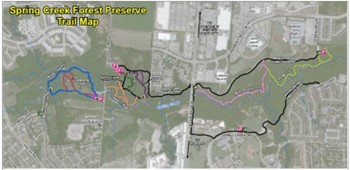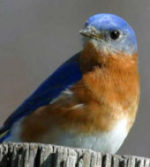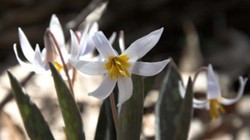March 2024
Speaker Series – Tina Rust – How to Map Trails using GPS – Tuesday, March 5 -7 – 8:30 p.m. – Zoom
 Trail map created by Tina Rust In November 2020, the society sought volunteers to help map the park trails. David Parrish took the lead, collecting GPS points along most of the trail network; while Tina Rust, a Texas Master Naturalist and GIS analyst, then utilized these points in ArcGIS to begin creating a map for park visitors. Subsequent site visits were conducted to gather and incorporate landmarks such as picnic tables, benches, and parking areas. Through collaborative editing sessions with Dana Wilson and society members, a full-color trail map was developed and added to the website.
Tina and David will share their insights on the trail mapping process at Spring Creek Forest Preserve and offer valuable ideas that can be adopted by other parks. Tina will also lead the 4th Sunday walk at Spring Creek Park Preserve, 1787 Holford, Sunday, March 24.
Tina, a certified GIS Professional, Archaeologist and Texas Master Naturalist, possesses a deep passion for merging her expertise in fieldwork, mapping and databases. This passion found a perfect outlet in the project of mapping nature trails at Spring Creek Preserve.
Note: Also on March 5, Society Members that attend the Zoom meeting will vote on incoming Executive Committee members.
Special Garland Cultural Arts Event – Night at the Museum: Gallery Walk – Including display of artwork by Anne Weary – March 8 – 5 – 8 p.m. – Granville Arts Center
Anne Weary grew up living in what was then a very rural part of Garland. Her father owned quite a bit of land along Holford Road between Arapaho Road and what is now George Bush Tollway. She rode her horse, they had a few cattle and their historic house had been built in 1936. She loved to draw the creek, forest and prairie adjacent to their house. That forest and prairie is now our preserve.
Anne is a well-known artist who still loves to draw what she sees in nature. You can meet Anne at her display on March 8.
The Garland Night at the Museum program is a Gallery walk around Downtown Garland’s newly designated Bankhead Cultural Arts District. Check in for the free event at the Garland Landmark Museum, 393 N. Sixth Street, Garland. At the Landmark Museum, there will be an exclusive showing of a David Bates original sculpture. David Bates is a nationally acclaimed artist who grew up in Garland and attended Garland High School. Best known for his paintings on canvas or panel, Bates is also prolific in sculpture and works on paper.
Gallery shows will continue (easy walking instructions will be provided) at Ninth Street Gallery, owned by Michelle Noah and Epiphany Gallery, owned by Leslie Montena. Attendees can experience a ‘pop-up gallery’ at 716 Main Street, formerly a church and Williams Funeral Home, featuring a projection exhibit by Garland-based artist, Trayc Claybrook. Finally, Anne Weary will be celebrating her exhibit opening at the Granville Arts Center.
Night at the Museum: Gallery Walk is free and open to the public.
Monthly Work Session – 6th Death to Privet work session – Saturday, March 9 – 9 – 11 a.m. – 1787 Holford
Happily, the part of the preserve at 1787 Holford is nearly clear of privet. We have our Death to Privet cleaning every year because when there used to be a lot of privet there, the bushes dropped thousands of pretty red berries. The seeds in those berries don’t all start growing at the same time. Some will stay dormant for several years before they put out roots and a stalk. Also, birds eat berries from other areas and drop the seeds where we don’t want them. So, every year, we search the area for newly arrived plants. We break into teams and each team has a knowledgeable volunteer, so you know exactly what to do.
More information about monthly work sessions is above.
 Photo by Marvin Rogers Bluebirds in the preserve, by Becky Sans, 2024
The Eastern Bluebird, Sialia sialis, nests only in North America, including the eastern two thirds of Texas, making observation of these jewels possible here in the DFW metroplex! The male has bright blue feathering, while the female’s coloring, having some blue tinges, is more drab. They both have rusty chests and white underparts. The male measures 6 ½ to 7 ½ inches. The female is slightly smaller.
Gardeners especially like this little bird because of their diet consisting primarily of insects on the ground – beetles, grasshoppers, and caterpillars – during the spring, summer, and early fall, and a variety of berries – holly, juniper, and mistletoe – during the winter. Present year-round, mating begins in February and nesting in March through July. Normally Bluebirds nest in natural forest tree cavities such as old woodpecker holes, but urban expansion and the resulting deforestation has greatly reduced these opportunities.
Today, manmade nest boxes are installed to provide this colorful species a second chance. Suitable nest box sites are open areas such as meadows and grasslands. An additional bonus for the birds is afternoon shading from the hot summer sun. Bluebirds require about ¾ acre to provide sufficient food for their families. For best results, nest boxes are installed in early fall.
Furthermore, all pesticide use, especially within a ½ mile radius of any nesting birds, is/should be prohibited.
In the 1950s, the use of the pesticide DDT almost extirpated the Bluebirds and eagles. Finally, predator monitoring is another best practice around nest boxes. House Sparrows and European Starling are small enough to access the nests, killing the nesting birds and destroying eggs. Snakes, raccoons, opossums and cats also will invade a nest box. Adding a baffle under the box will prevent some animals from entering.
For centuries the Navajo Indians and Early American settlers believed Bluebirds symbolized hope, renewal, and good fortune. These beliefs persist among the American population today. The thrill of seeing this little blue symbol of luck and good fortune remains for a lifetime. I saw my first Bluebird 38 years ago and remember it like it was yesterday. |

